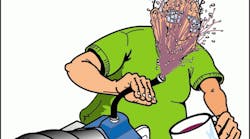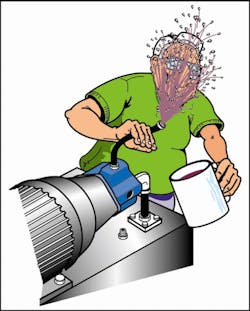Being misinformed can certainly lead to life-threatening consequences for the maintenance worker who deals with hydraulic or pneumatic systems. But misinformation extends far beyond the realm of bad word-of-mouth advice. Documented situations of hazardous recommendations for service, repair, and troubleshooting have occurred throughout the fluid power industry, leaving unsuspecting persons vulnerable to possible injury or death.
To demonstrate the reality and severity of the problem, we will examine excerpts from an unnamed troubleshooting booklet, written by a well-known publisher of fluid power textbooks.
This information was traced from its origin in Dallas to a technical college in Vancouver. It then made its way back into the service handbook of a coil-tubing machine manufacturer in Houston. A national hydraulic training company gives this handbook to hundreds of trainees yearly, as a reference manual.
Pump and relief valve test
The booklet recommends that workers “isolate the pump and relief valve from the circuit, so all you have is the pump, the relief valve, and a pressure gauge. Start the pump and dead-head the pump against the relief valve.”
This recommendation is unrealistic and impractical. It cannot be done if the pressure relief valve is integrated into the directional control valve housing. The majority of hand-operated valves are designed this way.
Next, they tell you to “watch for pressure on the gauge while tightening the adjustment on the relief valve. If full pressure can be developed, obviously the pump and relief valve are operating correctly, and the trouble is to be found further down the line. If full pressure cannot be developed in this test, continue with step 3.”
Wrong! If the relief valve is worn, it can still be set at specified pressure. If the spool can be lifted, the valve can be set.
Pump or relief valve?
The booklet recommends, “If high pressure cannot be obtained by running the pump against the relief valve, further testing must be conducted to see whether the fault lies in the pump or in the relief valve.”
You should then proceed as follows: “If possible, disconnect the reservoir return line from the relief valve. Attach a short length of hose to the relief valve outlet. Hold the open end of this hose over the reservoir filler opening so the rate of oil flow can be observed. Start the pump and run the relief valve adjustment up and down while observing the flow through the hose. If the pump is bad, there will probably be a full stream of oil when the relief valve adjustment is backed off, but this flow will diminish or stop as the adjustment is increased. If a flow meter is available the flow can be measured and compared with the pump catalog rating.”
This is an outrageous recommendation from a safety point of view, as seen in Figure 1. It contains too many unknowns! How much flow? Could the hose whip out of your hand? What if the oil flowing from the open hose strikes the top of the reservoir and sprays into your face? What is the temperature of the oil?
The booklet continues: “If a flow meter is not available, the rate of flow on small pumps can be measured by discharging the hose into a bucket while timing with the sweep hand on a watch. For example, if a volume of 10 gal is collected in 15 seconds, the pumping rate is 40 gpm, etc.”
Once again, you are discharging an unknown amount of oil at an unknown temperature to atmosphere — another fallacious recommendation! Plus, it is technically wrong — it is physically impossible to properly test a hydraulic pump at no load (low pressure).
Cylinder testing
The same manual recommends, “Run the piston to one end of its stroke and leave it stalled in this position under pressure. Crack the fitting on the same end of the cylinder to check for fluid leakage. After checking, tighten the fitting and run the piston to the opposite end of the barrel and repeat the test. Occasionally a cylinder will leak at one point in its stroke due to a scratch or dent in the barrel.
Check suspected position in mid-stroke by installing a positive stop at the suspected position and run the piston rod against it for testing. Once in a great while, a piston seal may leak intermittently. This is usually caused by a soft packing or O-ring moving slightly or rolling into different positions on the piston, and it is more likely to happen on large-bore cylinders.
When making this test on hydraulic cylinders, the line should be completely removed from a cylinder port during the test, and the open line from the valve should be plugged or capped since a slight backpressure in the tank return line would spill oil from the line if not plugged. Pistons with metal ring seals can be expected to have a small amount of leakage across the rings, and even those “leak-tight” soft seals may have a small bypass during break-in of new seals or after the seals are well worn.”
How confusing! Which end of the cylinder is the “same end?” When installing a “positive stop” to check the “mid-stroke” position, should you not take into account the potential force output of the cylinder? In one plant, a mechanic suffered an accident that severed his nose, and the majority of his front teeth were knocked out when he attempted to stall a hydraulic cylinder with a cable — which snapped, due to excessive force!
Once again, you are being told to “crack” a connector, or completely remove a transmission line, and check the condition of a hydraulic system that could operate at pressures up to 6000 psi and flows in excess of 100 gpm, to atmosphere. This recommendation is absolutely dangerous!
4-way directional valve testing
For testing 4-way valves, either air or hydraulic, the booklet tells us that it is necessary to obtain access to the exhaust or tank return ports so that the amount of leakage can be observed. To make the test, disconnect both cylinder lines and plug these ports on the valve. Start up the system and shift the valve to one working position. Any flow out the exhausts or tank return line while the valve is under pressure is the amount of leakage. Repeat the test in all other working positions of the valve.
Once again, this is an outrageous and improper suggestion — one of the most ludicrous recommendations in this troubleshooting booklet. Consider what will happen if the valve has an open-center, or tandem-center spool configuration. When you start the system, what are you going to do with the “who-knows-how-much” oil, at the “who-knows-what” temperature?
Note: Any recommendation to exhaust hydraulic oil to atmosphere to “test” any and all hydraulic components is fallacious — the outcome is unpredictable!
Passing on bad information
The same information, written word-for-word, appeared in a handout given to a millwright student in a technical college in British Columbia. He had to study the procedures, and pass a written exam to earn his millwright certificate. Upon graduation from college, he was hired by a local sawmill as a millwright, where his job was, among other things, to maintain the company’s various manufacturing machines, almost all of which are hydraulic.
Now we trace the exact information, again, word-for-word, to a company that manufactures coil-tubing equipment in Houston. The potentially hazardous troubleshooting procedures show up in the company’s service and repair manual.
This information will be dispersed to poorly trained oil-field service mechanics who have to service, repair, and troubleshoot the company’s fleet of oil-well service equipment. Sadly, only one of the three major oil-field service company’s makes hydraulic safety training mandatory for all their maintenance employees.
Again, the incorrect information is passed along, this time to a national hydraulic training company. Literally thousands of these booklets find their way into people’s hands through schools and colleges. The company gives them to everyone who attends their seminars. They claim to have trained over a quarter of a million people.
Conclusion
The authors of hydraulic service, repair, and troubleshooting information have a moral and ethical obligation to write proven, safety-based information — what they recommend is what people are going to do!
Here are some suggestions:
1. The service, repair, and troubleshooting procedures that you write must be safe, reliable, accurate, practical, comprehensive, and proven.
2. The information must pertain to the people who are going to use it. If it’s meant for field-service personnel, make it field-service-oriented. Likewise, if it’s for engineers, make it engineering-oriented.
3. It is pointless to assign writing procedures for doing a task to a person who has never done that task before. If you have not personally done the job, you may overlook some vital steps or make unrealistic recommendations.
4. Always assume that the people who age going to use your information are either untrained or poorly trained. Hydraulics training for maintenance personnel is generally a privilege, not a requirement.
5. Give as much information about general safety as possible. Explain the importance of locking the machine out, wearing safety glasses, etc.
6. Absolutely make no compromises! Don’t assume that maintenance personnel have the proper diagnostic equipment — they probably do not! Insist that they either have the proper diagnostic equipment and know how to use it, or they simply don’t do the job.
7. Lead by the most impeccable example. Follow the advice of your own technical services department, and don’t take short cuts. Follow every safety rule, use the proper diagnostic equipment, and explain to untrained personnel — who might be watching you — that you are trained to do your job, and that they, in your absence, should not try it until they have been properly trained.
8. Before you decide what reference material is best for your students, read it yourself. Seek information that is safety-based, clearly written, and practical.
Rory McLaren is president, Fluid Power Training Institute, Salt Lake City. For more information, call (801) 908-5456, email [email protected], or visit www.fpti.org.
Caution: Rory McLaren and the Fluid Power Training Institute do everything possible to ensure that the information and drawings contained in these reports are accurate and that the suggested procedures are deemed safe and reliable. However, these are general recommendations only and might not be applicable to all situations. You must have your engineering and service departments read these recommendations and make the necessary changes for your specific conditions.The Fluid Power Training Institute is not responsible for actions taken by untrained or unauthorized persons. All hydraulic system service, repair, and troubleshooting should be conducted only by trained, authorized personnel.


